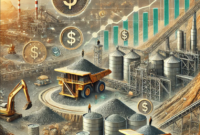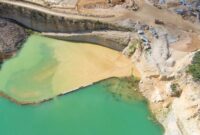Iron ore has long been a cornerstone of the global economy, driving the steel industry and infrastructure development. As demand for this critical resource continues to rise, investors are increasingly exploring ways to capitalize on the market’s fluctuations. Whether you’re a seasoned investor or new to the commodity market, investing in iron ore offers lucrative opportunities but also comes with its challenges. Understanding market trends and identifying key opportunities is essential for making informed decisions. In this article, we will delve into the dynamics of the iron ore market, highlight current trends, and explore how to navigate investment opportunities successfully.
Understanding Iron Ore and Its Importance
Iron ore is the primary raw material used to produce steel, one of the most vital materials in construction, transportation, and manufacturing industries. The demand for steel correlates directly with the demand for iron ore, making it a crucial indicator of economic growth.
Investing in iron ore can be a profitable venture for those who understand its role in the global market. Steel production accounts for about 98% of iron ore usage, with the remaining 2% used for other purposes, including industrial applications. As a result, the performance of the iron ore market is closely tied to the industrial output and infrastructure development around the world.
Investing in Iron Ore: Market Trends and Opportunities
In recent years, the iron ore market has experienced significant volatility, driven by various factors such as fluctuating demand, geopolitical tensions, and supply chain disruptions. However, these fluctuations also present opportunities for savvy investors to take advantage of price swings and capitalize on market trends.
Key Market Trends in Iron Ore Investment
- Global Demand and Urbanization:
Emerging economies, especially in Asia, have been the primary drivers of iron ore demand due to rapid urbanization and industrialization. Countries like China and India are investing heavily in infrastructure projects, boosting the demand for steel and, by extension, iron ore. - Supply Chain Challenges:
Iron ore production is concentrated in a few regions, such as Australia, Brazil, and Russia. Any disruption in these regions, whether due to natural disasters, political instability, or logistical challenges, can significantly impact the global supply and drive prices higher. Understanding these dynamics is essential when investing in iron ore stocks or futures. - Environmental Regulations and Sustainability Initiatives:
As governments around the world impose stricter environmental regulations, mining companies are under pressure to adopt more sustainable practices. This has led to higher production costs, potentially increasing iron ore prices over time. Investors who are aware of these shifts can identify companies that are leaders in sustainability and take advantage of potential long-term gains. - Technological Innovations:
Technological advancements in mining and transportation are reducing costs and improving efficiency. Automation, for instance, has streamlined operations, allowing companies to scale production while minimizing labor costs. Investing in iron ore companies that embrace technology could lead to better returns.
Investment Strategies for Iron Ore
- Direct Investment in Iron Ore Stocks:
Investors can buy shares in mining companies that produce iron ore. Major players like Rio Tinto, BHP, and Vale dominate the market. Analyzing their financial health, operational efficiency, and geographical presence can help investors make informed decisions. Keep an eye on their production costs, dividend yields, and stock performance relative to market trends. - Futures Contracts and ETFs:
For investors looking to hedge against price fluctuations or diversify their portfolios, iron ore futures and exchange-traded funds (ETFs) are viable options. Futures contracts allow investors to speculate on the price movements of iron ore, while ETFs offer exposure to a broad range of mining companies involved in iron ore production. - Junior Mining Stocks:
For those willing to take on more risk, investing in junior mining stocks can offer higher potential rewards. These smaller companies are often involved in exploration and have higher growth potential, but they also come with higher risk due to the uncertainty of discovery and production.
Opportunities and Risks in Iron Ore Investment
Investing in iron ore is not without its risks. Market volatility, geopolitical tensions, and regulatory changes can have a significant impact on the price of iron ore and the profitability of mining companies. However, there are also opportunities to benefit from these fluctuations.
Opportunities
- Infrastructure Investments:
Governments around the world are increasing infrastructure spending to support economic recovery, particularly after the COVID-19 pandemic. This is expected to drive up demand for steel and iron ore. Investors can take advantage of this trend by investing in companies that are well-positioned to benefit from infrastructure projects. - Increased Global Demand:
As economies like China and India continue to grow, their demand for iron ore will rise. Investors who are aware of these growth trends can position themselves to benefit from higher iron ore prices.
Risks
- Market Volatility:
The price of iron ore can be highly volatile, influenced by geopolitical tensions, global economic conditions, and supply chain disruptions. Investors must be prepared to weather these fluctuations and should consider diversifying their portfolios to mitigate risk. - Environmental Regulations:
Mining companies are facing increasing pressure to comply with environmental regulations, which can raise production costs and impact profitability. Investors should evaluate the environmental policies of the companies they invest in and consider how regulatory changes could affect their investments.
Conclusion
Investing in iron ore presents both opportunities and challenges. While market trends such as increasing global demand, supply chain disruptions, and sustainability initiatives offer potential for growth, investors must be aware of the risks associated with market volatility and regulatory changes. By understanding the dynamics of the iron ore market and adopting the right investment strategies, investors can navigate these trends and capitalize on opportunities in this vital sector.
FAQ
Q: What factors influence the price of iron ore?
A: The price of iron ore is influenced by global demand for steel, supply chain disruptions, geopolitical tensions, and environmental regulations. Economic growth in emerging markets, particularly in Asia, also plays a significant role in driving demand for iron ore.
Q: Is investing in iron ore risky?
A: Like any commodity, investing in iron ore comes with risks, including market volatility, regulatory changes, and geopolitical factors. However, with the right strategy and diversification, investors can mitigate some of these risks.
Q: What are the best ways to invest in iron ore?
A: Investors can invest in iron ore by purchasing stocks of mining companies, trading futures contracts, or investing in ETFs. Each method has its own risk and reward profile, so investors should choose based on their investment goals and risk tolerance.
Q: How does environmental regulation affect iron ore mining?
A: Environmental regulations can increase production costs for mining companies, which may lead to higher iron ore prices. Investors should consider how companies are responding to these regulations and whether they are leaders in sustainability.
By staying informed about market trends and understanding the key drivers of the iron ore market, investors can make well-informed decisions and potentially reap significant rewards from this essential commodity.




